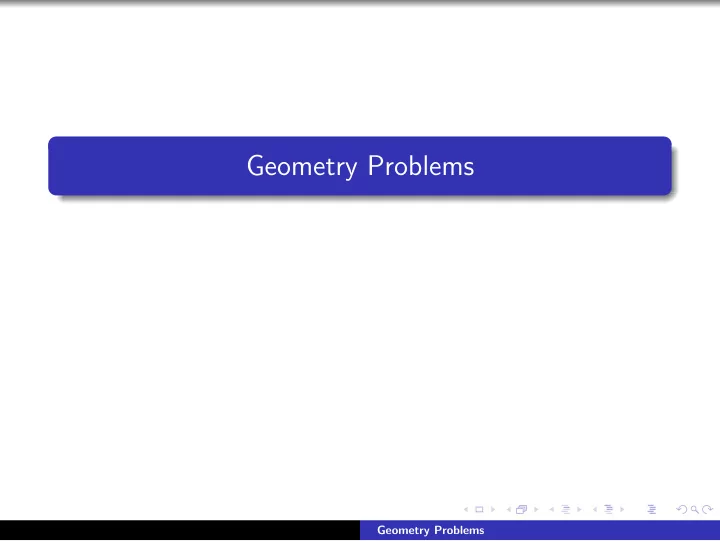

Geometry Problems Geometry Problems
Examples for Typical ACM Instances Elementary Geometry application of sine/cosine formulas spherical coordinates distances between lines, line segments, polygons, etc. area formulas Algorithmic Geometry convex hull intersection testing iterative approach for maximising/minimising objective function Geometry Problems
Traps and Tips Traps numerical problems (rule of thumb: use double, not float) input can contain collinear points or same points twice slope of a line can become infinity Tips sometimes brute force is good enough can you apply a plane-sweep/scan-line algorithm? http://www.faqs.org/faqs/graphics/algorithms-faq/ http://mathworld.wolfram.com http://www.ics.uci.edu/~eppstein/junkyard/ Geometry Problems
Floating Point Numbers IEEE 754 sign bit, biased exponent, significand (mantissa) float: 32 bit, sign 1, exponent 8, significand 23 (about 7 decimal digits) double 64 bit, sign 1, exponent 11, significand 52 bit (about 16 decimal digits) long double, nonstandard 96bit storage but only 80bit precision, sign 1, exponent 15, significand 63 (in Java use BigDecimal) only subset of the reals. e.g 1 3 not representable ⇒ rounding to nearest Geometry Problems
Floating Point Numbers Example: π π rounded to 24 bits: 11.001001000011111101101 significand = 1 . 10010010000111111011011 exponent = 1 ⇒ π = 1 . 10010010000111111011011 · 2 1 Geometry Problems
Absolute vs. Relative Error Absolute Error During arithmetic floating-point operations a loss of precision can occur. How can one test the equality of two numbers? Absolute error: | a − b | < ǫ . Geometry Problems
Absolute vs. Relative Error Absolute Error During arithmetic floating-point operations a loss of precision can occur. How can one test the equality of two numbers? Absolute error: | a − b | < ǫ . Example 32-bit floating point calculation with an expected result of 10000. Precision of 6 decimal digits ( ǫ = 0 . 000001). However, the result is 10000 . 000977 (nearest number to 10000 using 32-bit float) Absolute error: 0 . 000977 = 977 · ǫ . Solution: Use relative error. Geometry Problems
Absolute vs. Relative Error Relative Error Relative error: | ( a − b ) / b | < ǫ . In our case: 0 . 0000000977 < 0 . 000001 Geometry Problems
Absolute vs. Relative Error Relative Error Relative error: | ( a − b ) / b | < ǫ . In our case: 0 . 0000000977 < 0 . 000001 Summary Absolute error doesn’t work for big positive and negative numbers. Relative error doesn’t work not for numbers around 0. Why? ⇒ Two numbers are equal if: | a − b | < ǫ or | ( a − b ) / b | < ǫ . Smallest epsilon for 32-bit float: 1 . 19209 · 10 − 07 . Smallest epsilon for 64-bit float: 2 . 22045 · 10 − 16 . Geometry Problems
Closest Pair of Points Algorithms Geometry Problems
Closest Pair of Points Algorithms Voronoi diagram Delaunay triangulation or (easier) Divide and Conquer Plane-Sweep / Scan-Line Geometry Problems
Convex Hull Algorithms Geometry Problems
Convex Hull Algorithms Voronoi Diagram (points of unbounded regions) or (easier) Gift Wrapping Graham Scan Quickhull Divide and Conquer Incremental Double-Chain Geometry Problems
Recommend
More recommend